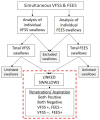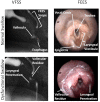Simultaneous Videofluoroscopy and Endoscopy for Dysphagia Evaluation in Preterm Infants-A Pilot Study
- PMID: 33042904
- PMCID: PMC7522365
- DOI: 10.3389/fped.2020.00537
Simultaneous Videofluoroscopy and Endoscopy for Dysphagia Evaluation in Preterm Infants-A Pilot Study
Abstract
Introduction: The assessment of dysphagia in preterm infants has been limited to clinical bedside evaluation followed by videofluoroscopic swallow study (VFSS) in selected patients. Recently, fiberoptic endoscopic evaluation of swallowing (FEES) is being described more in literature for preterm infants. However, it is unclear if one test has a better diagnostic utility than the other in this population. Furthermore, it is also unclear if performing FEES and VFSS simultaneously will increase the sensitivity and specificity of detecting dysphagia compared to either test performed independently. Objectives: The primary objective of this study is to evaluate the feasibility of performing VFSS and FEES simultaneously in preterm infants. Our secondary objective is to determine whether simultaneously performed VFSS-FEES improves the diagnostic ability in detecting dysphagia in preterm infants compared to either test done separately. Methods: In this pilot study, we describe the process involved in performing simultaneous VFSS-FEES in five preterm infants (postmenstrual age ≥36 weeks) with dysphagia. A total of 26 linked VFSS-FEES swallows were analyzed, where the same bolus during the same swallow was compared using simultaneous fluoroscopy and endoscopy. The sensitivity and specificity of detecting penetration and aspiration were evaluated in simultaneous VFSS-FEES compared with each test done independently. Results: Our results demonstrated that performing simultaneous VFSS-FEES is feasible in preterm infants with dysphagia. All patients tolerated the procedures well without any complications. Our pilot study in these five symptomatic preterm infants demonstrated a low incidence of aspiration but a high incidence of penetration. Simultaneous VFSS-FEES (26 linked swallows) improved the ability to detect penetration compared to each test done separately. Conclusion: To our knowledge, this study is the first to demonstrate the feasibility of performing VFSS and FEES simultaneously in symptomatic preterm infants with dysphagia resulting in potentially higher diagnostic yield than either procedure done separately.
Keywords: dysphagia; fiberoptic endoscopic evaluation of swallowing (FEES); laryngeal penetration; modified barium swallow study; preterm infant; swallowing dysfunction; tracheal aspiration; videofluoroscopy.
Copyright © 2020 Kamity, Ferrara, Dumpa, Reynolds, Islam and Hanna.
Figures





Similar articles
-
Exploring the utility of fibreoptic endoscopic evaluation of swallowing in young children- A comparison with videofluoroscopy.Int J Pediatr Otorhinolaryngol. 2020 Nov;138:110339. doi: 10.1016/j.ijporl.2020.110339. Epub 2020 Aug 29. Int J Pediatr Otorhinolaryngol. 2020. PMID: 32911239
-
Fiberoptic endoscopic evaluation of swallowing (FEES) in children with spinal muscular atrophy type 1: feasibility, swallowing safety and efficacy, and dysphagia phenotype.Eur Arch Otorhinolaryngol. 2024 Dec;281(12):6523-6532. doi: 10.1007/s00405-024-08922-4. Epub 2024 Sep 4. Eur Arch Otorhinolaryngol. 2024. PMID: 39230607 Free PMC article.
-
Correlations between Aspiration and Pharyngeal Residue Scale Scores for Fiberoptic Endoscopic Evaluation and Videofluoroscopy.Yonsei Med J. 2019 Dec;60(12):1181-1186. doi: 10.3349/ymj.2019.60.12.1181. Yonsei Med J. 2019. PMID: 31769249 Free PMC article.
-
Fiberoptic Endoscopic Evaluation of Swallowing: A Multidisciplinary Alternative for Assessment of Infants With Dysphagia in the Neonatal Intensive Care Unit.Adv Neonatal Care. 2016 Feb;16(1):37-43. doi: 10.1097/ANC.0000000000000245. Adv Neonatal Care. 2016. PMID: 26709466 Review.
-
Fiberoptic Endoscopic Evaluation of Swallowing in Infants and Children: Protocol, Safety, and Clinical Efficacy: 25 Years of Experience.Ann Otol Rhinol Laryngol. 2020 May;129(5):469-481. doi: 10.1177/0003489419893720. Epub 2019 Dec 17. Ann Otol Rhinol Laryngol. 2020. PMID: 31845586 Review.
Cited by
-
Determination of oral feeding skills in late preterm, early term, and full-term infants using the neonatal oral feeding monitor (NeoSAFE).Ital J Pediatr. 2025 Feb 7;51(1):38. doi: 10.1186/s13052-025-01867-2. Ital J Pediatr. 2025. PMID: 39920842 Free PMC article.
-
From Warm to Cold: Feeding Cold Milk to Preterm Infants with Uncoordinated Oral Feeding Patterns.Nutrients. 2025 Apr 26;17(9):1457. doi: 10.3390/nu17091457. Nutrients. 2025. PMID: 40362766 Free PMC article. Clinical Trial.
-
Visual Analysis of Swallowing Efficiency and Safety (VASES): A Standardized Approach to Rating Pharyngeal Residue, Penetration, and Aspiration During FEES.Dysphagia. 2022 Apr;37(2):417-435. doi: 10.1007/s00455-021-10293-5. Epub 2021 Apr 10. Dysphagia. 2022. PMID: 33837841
-
Using Machine Learning for the Automated Segmentation and Detection of Swallows Obtained by Digital Cervical Auscultation in Preterm Neonates.Dysphagia. 2025 Sep 12. doi: 10.1007/s00455-025-10879-3. Online ahead of print. Dysphagia. 2025. PMID: 40936063
-
Differences in the swallowing process of newborns and healthy preterm infants: first results with a non-invasive bioimpedance and electromyography measurement system.Eur Arch Otorhinolaryngol. 2024 Feb;281(2):843-854. doi: 10.1007/s00405-023-08344-8. Epub 2023 Nov 24. Eur Arch Otorhinolaryngol. 2024. PMID: 37996534 Free PMC article.
References
LinkOut - more resources
Full Text Sources

